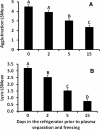The effect of hydration state and energy balance on innate immunity of a desert reptile
- PMID: 23642164
- PMCID: PMC3660207
- DOI: 10.1186/1742-9994-10-23
The effect of hydration state and energy balance on innate immunity of a desert reptile
Abstract
Introduction: Immune function is a vital physiological process that is often suppressed during times of resource scarcity due to investments in other physiological systems. While energy is the typical currency that has been examined in such trade-offs, limitations of other resources may similarly lead to trade-offs that affect immune function. Specifically, water is a critical resource with profound implications for organismal ecology, yet its availability can fluctuate at local, regional, and even global levels. Despite this, the effect of osmotic state on immune function has received little attention.
Results: Using agglutination and lysis assays as measures of an organism's plasma concentration of natural antibodies and capacity for foreign cell destruction, respectively, we tested the independent effects of osmotic state, digestive state, and energy balance on innate immune function in free-ranging and laboratory populations of the Gila monster, Heloderma suspectum. This desert-dwelling lizard experiences dehydration and energy resource fluctuations on a seasonal basis. Dehydration was expected to decrease innate immune function, yet we found that dehydration increased lysis and agglutination abilities in both lab and field studies, a relationship that was not simply an effect of an increased concentration of immune molecules. Laboratory-based differences in digestive state were not associated with lysis or agglutination metrics, although in our field population, a loss of fat stores was correlated with an increase in lysis.
Conclusions: Depending on the life history of an organism, osmotic state may have a greater influence on immune function than energy availability. Thus, consideration of osmotic state as a factor influencing immune function will likely improve our understanding of ecoimmunology and the disease dynamics of a wide range of species.
Figures





Similar articles
-
Dehydration enhances multiple physiological defense mechanisms in a desert lizard, Heloderma suspectum.J Exp Biol. 2017 Jun 15;220(Pt 12):2166-2174. doi: 10.1242/jeb.150367. Epub 2017 Apr 21. J Exp Biol. 2017. PMID: 28432151
-
Reproduction Alters Hydration State but Does Not Impact the Positive Effects of Dehydration on Innate Immune Function in Children's Pythons (Antaresia childreni).Physiol Biochem Zool. 2017 Nov/Dec;90(6):646-654. doi: 10.1086/694834. Physiol Biochem Zool. 2017. PMID: 28991506
-
When less means more: dehydration improves innate immunity in rattlesnakes.J Exp Biol. 2017 Jun 15;220(Pt 12):2287-2295. doi: 10.1242/jeb.155028. Epub 2017 Apr 12. J Exp Biol. 2017. PMID: 28404727
-
Leptin as a physiological mediator of energetic trade-offs in ecoimmunology: implications for disease.Integr Comp Biol. 2011 Oct;51(4):505-13. doi: 10.1093/icb/icr019. Epub 2011 May 5. Integr Comp Biol. 2011. PMID: 21940777 Free PMC article. Review.
-
A trade-off model for immunocompetence: The potential contribution of immunological regulation in invasive vertebrate success.J Exp Zool A Ecol Integr Physiol. 2019 Nov;331(9):478-484. doi: 10.1002/jez.2314. Epub 2019 Aug 7. J Exp Zool A Ecol Integr Physiol. 2019. PMID: 31389203 Review.
Cited by
-
Muscles provide an internal water reserve for reproduction.Proc Biol Sci. 2018 Jun 27;285(1881):20180752. doi: 10.1098/rspb.2018.0752. Proc Biol Sci. 2018. PMID: 30051850 Free PMC article.
-
A tale of two islands: evidence for impaired stress response and altered immune functions in an insular pit viper following ecological disturbance.Conserv Physiol. 2020 May 3;8(1):coaa031. doi: 10.1093/conphys/coaa031. eCollection 2020. Conserv Physiol. 2020. PMID: 32382421 Free PMC article.
-
Recovery from discrete wound severities in side-blotched lizards (Uta stansburiana): implications for energy budget, locomotor performance, and oxidative stress.J Comp Physiol B. 2021 May;191(3):531-543. doi: 10.1007/s00360-021-01347-z. Epub 2021 Feb 13. J Comp Physiol B. 2021. PMID: 33582858
-
Chronic debilitation in stranded loggerhead sea turtles (Caretta caretta) in the southeastern United States: Morphometrics and clinicopathological findings.PLoS One. 2018 Jul 10;13(7):e0200355. doi: 10.1371/journal.pone.0200355. eCollection 2018. PLoS One. 2018. PMID: 29990325 Free PMC article.
-
Water availability and environmental temperature correlate with geographic variation in water balance in common lizards.Oecologia. 2017 Dec;185(4):561-571. doi: 10.1007/s00442-017-3973-6. Epub 2017 Oct 10. Oecologia. 2017. PMID: 29018996
References
-
- Lochmiller RL, Deerenberg C. Trade-offs in evolutionary immunology: just what is the cost of immunity? Oikos. 2000;88:87–98. doi: 10.1034/j.1600-0706.2000.880110.x. - DOI
LinkOut - more resources
Full Text Sources
Other Literature Sources
Miscellaneous

